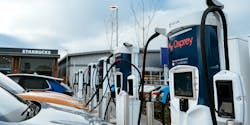Tritium providing 250 EV chargers to the Osprey Charging Network in the U.K.
EV chargers developer Tritium DCFC Limited will supply over 250 rapid chargers to the Osprey Charging Network, which is among the fastest-growing rapid EV charging points networks in the U.K.
The Competition and Markets Authority expects the U.K. to require a minimum of 280,000 to 480,000 public charging points by 2030 to ensure accessibility. Tritium’s 250 new chargers will contribute to the achievement of this goal.
The new chargers will expand the network by 50%.
Tritium CEO Jane Hunter pointed out that more than 190,000 new electric vehicles were sold in the UK last year, a 76-percent increase over 2020.
Osprey CEO Ian Johnson praised the quality of Tritium fast chargers.
“As an independent charge point operator, we have the freedom to work with the very best hardware companies so that we can provide the very best experience for our customers,” said Ian Johnston, Osprey CEO. “We have already installed Tritium rapid chargers at many of our most popular locations, including sites with improved accessibility and at our South London high-power charging hub. We are excited to add the dynamic load-balancing PKM chargers to our rapidly expanding UK network, optimising charger output across a number of cars plugged in simultaneously and ultimately improving driver experience. Tritium is an instrumental partner in helping Osprey deliver on our goal of creating a high quality, inclusive, reliable charging network that’s worry free and accessible for all.”
See our full coverage of e-Mobility's growing role in the C&I Energy Transition
Subscribe to EnergyTech's free newsletter for more stories like this
Earlier, Osprey and another EC charging software and services firm, GreenFlux, signed a roaming agreement which opened the Osprey network to nearly 90,000 EV drivers. It allowed cross-Channel charging in Europe and the UK.
Drivers served by GreenFlux can can access all Osprey chargers both installed and added in the future.
One of the GreenFlux customers benefitting from the agreement is DKV Mobility, an e-mobility service provider for commercial vehicle fleets across Europe. With this agreement, DKV Mobility can expand its service offering for fleets in the UK, by allowing commercial drivers to access Osprey’s chargers.
-- -- --
(Rod Walton, senior editor for EnergyTech, is a 14-year veteran of covering the energy industry both as a newspaper and trade journalist. He can be reached at [email protected]).
About the Author
Rod Walton, EnergyTech Managing Editor
Managing Editor
For EnergyTech editorial inquiries, please contact Managing Editor Rod Walton at [email protected].
Rod Walton has spent 17 years covering the energy industry as a newspaper and trade journalist. He formerly was energy writer and business editor at the Tulsa World. Later, he spent six years covering the electricity power sector for Pennwell and Clarion Events. He joined Endeavor and EnergyTech in November 2021.
Walton earned his Bachelors degree in journalism from the University of Oklahoma. His career stops include the Moore American, Bartlesville Examiner-Enterprise, Wagoner Tribune and Tulsa World.
EnergyTech is focused on the mission critical and large-scale energy users and their sustainability and resiliency goals. These include the commercial and industrial sectors, as well as the military, universities, data centers and microgrids. The C&I sectors together account for close to 30 percent of greenhouse gas emissions in the U.S.
He was named Managing Editor for Microgrid Knowledge and EnergyTech starting July 1, 2023
Many large-scale energy users such as Fortune 500 companies, and mission-critical users such as military bases, universities, healthcare facilities, public safety and data centers, shifting their energy priorities to reach net-zero carbon goals within the coming decades. These include plans for renewable energy power purchase agreements, but also on-site resiliency projects such as microgrids, combined heat and power, rooftop solar, energy storage, digitalization and building efficiency upgrades.

